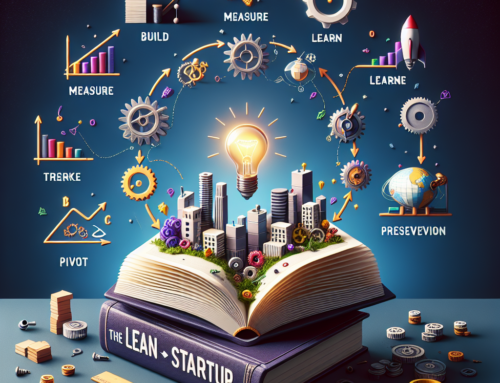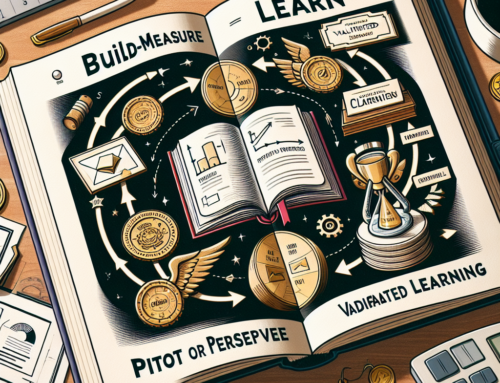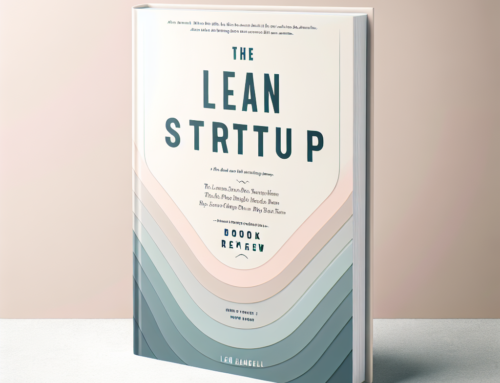
Key Principles Of The Lean Startup Methodology
”The Lean Startup” by Eric Ries has become a seminal text in the world of entrepreneurship, offering a fresh perspective on how to build and scale startups efficiently. At its core, the Lean Startup methodology is designed to help entrepreneurs navigate the uncertainties of launching a new business by emphasizing rapid experimentation, validated learning, and iterative product development. This approach stands in stark contrast to traditional business plans that often rely on extensive upfront planning and significant capital investment.
One of the key principles of the Lean Startup methodology is the concept of the Minimum Viable Product (MVP). The MVP is a simplified version of a product that allows a startup to test its core assumptions with minimal resources. By releasing an MVP, entrepreneurs can gather valuable customer feedback early in the development process, which helps them understand whether their product meets a real market need. This feedback loop is crucial because it enables startups to pivot or persevere based on actual user data rather than assumptions.
Another fundamental aspect of the Lean Startup approach is the Build-Measure-Learn feedback loop. This iterative cycle encourages startups to build a basic version of their product, measure how it performs in the market, and learn from the results. The insights gained from this process inform the next iteration of the product, ensuring that each version is more aligned with customer needs than the last. This continuous improvement cycle helps startups avoid the pitfalls of over-engineering and ensures that they remain agile and responsive to market demands.
Moreover, the Lean Startup methodology places a strong emphasis on validated learning. Unlike traditional metrics that focus on vanity indicators such as website traffic or social media likes, validated learning seeks to measure progress through actionable metrics that directly correlate with business success. For instance, instead of merely tracking the number of app downloads, a startup might focus on user retention rates or the frequency of specific in-app actions. These metrics provide a more accurate picture of whether the product is delivering real value to its users.
In addition to these principles, the Lean Startup methodology advocates for the use of innovation accounting. This involves setting clear, measurable goals and using data to track progress towards those goals. By breaking down the startup’s journey into smaller, manageable milestones, entrepreneurs can make more informed decisions and allocate resources more effectively. This approach not only helps in maintaining focus but also provides a structured framework for evaluating the startup’s performance over time.
Furthermore, the Lean Startup methodology encourages a culture of experimentation and learning within the organization. By fostering an environment where failure is seen as an opportunity for growth rather than a setback, startups can cultivate a mindset of continuous improvement. This cultural shift is essential for sustaining long-term innovation and adaptability, which are critical for success in today’s fast-paced business landscape.
In conclusion, the Lean Startup methodology offers a comprehensive framework for building and scaling startups in a resource-efficient manner. By focusing on rapid experimentation, validated learning, and iterative development, entrepreneurs can navigate the uncertainties of the startup world with greater confidence and agility. The principles outlined in Eric Ries’ book provide valuable insights that can help startups not only survive but thrive in a competitive market. Whether you’re a seasoned entrepreneur or just starting out, the Lean Startup methodology offers practical tools and strategies that can significantly enhance your chances of success.
How To Implement Build-Measure-Learn In Your Startup
The Lean Startup by Eric Ries has become a cornerstone for modern entrepreneurs, offering a fresh perspective on how to build successful startups. Central to Ries’ methodology is the Build-Measure-Learn feedback loop, a process designed to help startups efficiently develop products that meet customer needs. Implementing this cycle in your startup can be transformative, and understanding how to do so effectively is crucial.
To begin with, the ”Build” phase is where you create a Minimum Viable Product (MVP). This MVP is not a final product but a simplified version that includes only the core features necessary to test your hypothesis. The goal here is to avoid wasting resources on features that customers may not want. For instance, if you’re developing a new app, your MVP might be a basic version that performs the essential functions without any bells and whistles. By focusing on the MVP, you can quickly get your product into the hands of users and start gathering feedback.
Once your MVP is built, the next step is to ”Measure.” This phase involves collecting data on how users interact with your product. It’s essential to establish key performance indicators (KPIs) that align with your business goals. These metrics will help you determine whether your hypothesis is correct. For example, if your hypothesis is that users will find your app easy to navigate, you might measure the time it takes for them to complete specific tasks. Tools like Google Analytics, Mixpanel, or even simple surveys can provide valuable insights into user behavior.
After gathering data, you move on to the ”Learn” phase. This is where you analyze the data to draw meaningful conclusions. Did users find your app easy to navigate? Did they use the features you thought they would? This phase is crucial because it informs your next steps. If the data supports your hypothesis, you can proceed with confidence. If not, it’s time to pivot or make adjustments. For example, if users struggled with navigation, you might need to redesign the user interface. The key is to remain flexible and open to change based on what the data tells you.
Transitioning smoothly from one phase to the next is vital for maintaining momentum. After learning from your data, you return to the Build phase, but this time with more information. You can now make informed decisions about what features to add or modify. This iterative process ensures that you are continually improving your product based on real user feedback, rather than assumptions.
Moreover, communication within your team is essential throughout this cycle. Regular meetings to discuss findings and next steps can keep everyone aligned and focused. It’s also beneficial to document each iteration, noting what worked and what didn’t. This documentation can serve as a valuable resource for future projects and help avoid repeating past mistakes.
In addition, involving customers in the process can provide deeper insights. Engaging with your user base through forums, social media, or direct feedback sessions can offer perspectives that data alone might not reveal. This customer-centric approach ensures that you are building something that truly meets their needs.
In conclusion, implementing the Build-Measure-Learn cycle in your startup is a dynamic and ongoing process. By focusing on creating an MVP, measuring user interactions, and learning from the data, you can make informed decisions that drive your startup toward success. This methodology not only saves time and resources but also fosters a culture of continuous improvement and adaptability. So, embrace the Build-Measure-Learn cycle and watch your startup thrive.
Real-World Success Stories Using The Lean Startup Approach
The Lean Startup by Eric Ries has revolutionized the way entrepreneurs approach building and scaling their businesses. By emphasizing rapid experimentation, validated learning, and iterative product releases, Ries provides a framework that helps startups navigate the uncertainties of the market. To truly appreciate the impact of The Lean Startup methodology, it is essential to explore real-world success stories that have embraced this approach and thrived.
One of the most notable examples is Dropbox, the cloud storage company that has become a household name. When Drew Houston and Arash Ferdowsi founded Dropbox, they faced the challenge of convincing users to adopt a new way of storing and sharing files. Instead of investing heavily in product development upfront, they created a simple video demonstrating the product’s functionality. This video went viral, generating significant interest and allowing them to gather valuable feedback from potential users. By using the Lean Startup principles of building a minimum viable product (MVP) and validating their assumptions early on, Dropbox was able to refine their offering and achieve exponential growth.
Similarly, the story of Airbnb illustrates the power of the Lean Startup approach. Founders Brian Chesky, Joe Gebbia, and Nathan Blecharczyk initially struggled to gain traction with their idea of renting out air mattresses in their apartment. However, by continuously iterating on their concept and engaging directly with their users, they were able to identify key pain points and improve their platform. They started by targeting events where accommodation was scarce, such as conferences, and gradually expanded their reach. This iterative process allowed them to build a product that resonated with users, ultimately transforming Airbnb into a global hospitality giant.
Another compelling example is Zappos, the online shoe retailer that was acquired by Amazon for over a billion dollars. Founder Nick Swinmurn began by testing the viability of selling shoes online without holding any inventory. He took photos of shoes from local stores and posted them on his website. When customers placed orders, he would purchase the shoes from the stores and ship them directly to the buyers. This approach allowed him to validate the demand for online shoe shopping before making significant investments in inventory and logistics. By leveraging the Lean Startup methodology, Zappos was able to build a successful business model that prioritized customer satisfaction and operational efficiency.
Moreover, the Lean Startup principles have also been effectively applied in the non-profit sector. Charity: Water, founded by Scott Harrison, aimed to provide clean drinking water to people in developing countries. Instead of launching large-scale projects from the outset, Harrison focused on small, manageable initiatives that could be tested and refined. By using data and feedback to guide their efforts, Charity: Water was able to optimize their strategies and maximize their impact. This approach not only ensured the efficient use of resources but also built trust with donors and beneficiaries alike.
In conclusion, the Lean Startup methodology has proven to be a game-changer for a diverse range of organizations. By prioritizing experimentation, customer feedback, and iterative development, companies like Dropbox, Airbnb, Zappos, and Charity: Water have been able to navigate the complexities of their respective markets and achieve remarkable success. These real-world examples underscore the value of adopting a lean mindset, demonstrating that with the right approach, even the most ambitious ideas can be transformed into thriving enterprises.
Overcoming Common Challenges In Lean Startup Adoption
”The Lean Startup” by Eric Ries has become a cornerstone in the entrepreneurial world, offering a fresh perspective on how to build and scale startups efficiently. However, despite its widespread acclaim, many entrepreneurs face common challenges when attempting to adopt the Lean Startup methodology. Understanding these challenges and how to overcome them can significantly enhance the chances of success.
One of the primary challenges is the resistance to change. Traditional business models often emphasize detailed planning and extensive market research before launching a product. In contrast, the Lean Startup approach advocates for a more iterative process, focusing on building a minimum viable product (MVP) and learning from customer feedback. This shift can be daunting for those accustomed to conventional methods. To overcome this, it is crucial to foster a culture of experimentation within the organization. Encouraging team members to embrace failure as a learning opportunity can help ease the transition and promote a more agile mindset.
Another common hurdle is the misinterpretation of the MVP concept. Many entrepreneurs mistakenly believe that an MVP should be a fully functional product, leading to over-engineering and unnecessary delays. In reality, an MVP is a simplified version of the product that allows for quick testing and feedback. By clearly defining the core features that address the primary customer problem, startups can develop an MVP that is both cost-effective and efficient. This approach not only saves time and resources but also provides valuable insights that can guide future development.
Furthermore, the Lean Startup methodology emphasizes the importance of validated learning, which involves testing hypotheses through experiments and using data to make informed decisions. However, some entrepreneurs struggle with designing effective experiments and interpreting the results. To address this challenge, it is essential to establish clear metrics and key performance indicators (KPIs) that align with the startup’s goals. By focusing on actionable metrics rather than vanity metrics, entrepreneurs can gain a deeper understanding of their progress and make data-driven decisions.
Additionally, securing buy-in from stakeholders can be a significant obstacle. Investors, board members, and even team members may be skeptical of the Lean Startup approach, especially if they are more familiar with traditional business practices. To gain their support, it is important to communicate the benefits of the methodology clearly. Highlighting successful case studies and demonstrating how the Lean Startup approach can reduce risk and increase the likelihood of success can help build confidence and garner the necessary support.
Moreover, maintaining momentum and avoiding burnout is another challenge that startups often face. The iterative nature of the Lean Startup methodology requires continuous testing, learning, and adapting, which can be exhausting for the team. To mitigate this, it is important to set realistic goals and celebrate small wins along the way. Regularly reviewing progress and adjusting strategies as needed can help maintain motivation and ensure that the team remains focused on the ultimate objective.
In conclusion, while the Lean Startup methodology offers a powerful framework for building and scaling startups, it is not without its challenges. By fostering a culture of experimentation, clearly defining the MVP, focusing on validated learning, securing stakeholder buy-in, and maintaining momentum, entrepreneurs can overcome these obstacles and maximize their chances of success. Embracing the Lean Startup approach requires a shift in mindset, but with persistence and dedication, it can lead to innovative solutions and sustainable growth.
The Role Of Innovation Accounting In Lean Startups
In ”The Lean Startup” by Eric Ries, one of the most compelling concepts introduced is that of innovation accounting. This idea serves as a cornerstone for lean startups, providing a structured approach to measuring progress, setting milestones, and prioritizing tasks. Unlike traditional accounting, which focuses on financial metrics, innovation accounting is designed to track the development of a startup’s product and its market fit. This method is particularly crucial for startups, which often operate in environments of extreme uncertainty and need a way to validate their assumptions quickly and efficiently.
To begin with, innovation accounting helps startups move away from vanity metrics—those numbers that look good on paper but don’t necessarily translate into meaningful business outcomes. Instead, it encourages the use of actionable metrics that can guide decision-making. For instance, rather than merely tracking the number of website visitors, a startup might focus on the conversion rate of those visitors into paying customers. This shift in focus ensures that the team is working towards goals that genuinely matter for the business’s growth and sustainability.
Moreover, innovation accounting introduces the concept of learning milestones. These are specific, measurable checkpoints that help a startup determine whether it is making progress in its quest to find a sustainable business model. By setting these milestones, startups can systematically test their hypotheses about the market, customer needs, and product features. This iterative process allows for rapid experimentation and learning, which is essential for adapting to changing market conditions and customer feedback.
Another critical aspect of innovation accounting is its role in resource allocation. Startups often operate with limited resources, making it imperative to allocate time, money, and effort efficiently. By using innovation accounting, startups can identify which activities are driving the most value and which are not. This enables them to double down on successful strategies while pivoting away from less effective ones. For example, if a particular marketing campaign is not yielding the expected results, innovation accounting can help identify this early on, allowing the startup to reallocate resources to more promising initiatives.
Furthermore, innovation accounting fosters a culture of accountability and transparency within the startup. By making progress measurable and visible, it ensures that everyone in the organization is aligned with the same goals and understands their role in achieving them. This shared understanding can significantly enhance team cohesion and motivation, as everyone can see how their efforts contribute to the startup’s overall success.
In addition to its internal benefits, innovation accounting also plays a crucial role in external communications, particularly with investors. Startups often need to demonstrate their progress and potential to secure funding. Traditional financial metrics may not be sufficient to convey the true state of a startup’s development. Innovation accounting provides a more nuanced and accurate picture, showcasing the startup’s learning and growth trajectory. This can be particularly persuasive for investors who are looking for evidence of a startup’s ability to adapt and thrive in a competitive market.
In conclusion, innovation accounting is an indispensable tool for lean startups, offering a structured approach to measuring progress, setting milestones, and allocating resources. By focusing on actionable metrics, fostering accountability, and enhancing communication with stakeholders, it provides a comprehensive framework for navigating the uncertainties of startup life. Eric Ries’s emphasis on this concept in ”The Lean Startup” underscores its importance in building successful, sustainable businesses in today’s fast-paced and ever-changing market landscape.
We have lots of exciting coming events in Entrepreneurship, Investing and Personal Development. You can find them all here:
www.swedishwealthinstitute.se/events




